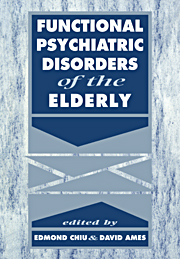Book contents
- Frontmatter
- Contents
- List of contributors
- Preface
- Introduction – A personal note
- Acknowledgement
- Part 1 Classification
- Part 2 General epidemiology
- Part 3 Neuroses
- Part 4 Affective disorders
- 7 The epidemiology of affective disorders in old age
- 8 The outcome of depressive illness in old age
- 9 Pseudodementia in geriatric depression
- 10 Depression in nursing and residential homes
- 11 Depression in primary care settings
- 12 Treatment of depression in the elderly
- 13 Mania in late life: conceptual and clinical issues
- 14 Suicide in the elderly
- Part 5 Psychosexual disorders
- Part 6 Substance use and abuse
- Part 7 Schizophrenia and related psychoses
- Part 8 Psychological, biological and medical issues
- Part 9 Treatment methods
- Part 10 Conclusion
- Index
12 - Treatment of depression in the elderly
from Part 4 - Affective disorders
Published online by Cambridge University Press: 13 November 2009
- Frontmatter
- Contents
- List of contributors
- Preface
- Introduction – A personal note
- Acknowledgement
- Part 1 Classification
- Part 2 General epidemiology
- Part 3 Neuroses
- Part 4 Affective disorders
- 7 The epidemiology of affective disorders in old age
- 8 The outcome of depressive illness in old age
- 9 Pseudodementia in geriatric depression
- 10 Depression in nursing and residential homes
- 11 Depression in primary care settings
- 12 Treatment of depression in the elderly
- 13 Mania in late life: conceptual and clinical issues
- 14 Suicide in the elderly
- Part 5 Psychosexual disorders
- Part 6 Substance use and abuse
- Part 7 Schizophrenia and related psychoses
- Part 8 Psychological, biological and medical issues
- Part 9 Treatment methods
- Part 10 Conclusion
- Index
Summary
Why treatment of depression in the elderly is different
Age is associated with differences in response to, and side-effects from, treatment. Pharmacokinetics alter with age (see Chapter 25), rates of pharmacologic sideeffects increase (see Chapter 25), issues of concern for psychotherapy are qualitatively distinct (see Chapters 27, 28, 29) and the outcome of electroconvulsive therapy (ECT) (see Chapter 26), even allowing for diagnosis, may be better in late life (Benbow, 1991).
Secondly, treatment differs in old age because of diagnostic variations. Depression in the elderly may appear phenomenologically similar to that in younger patients but have a different etiology. The reverse may hold too; a depression of putatively similar etiology is more likely to be psychotic and to be associated with psychomotor agitation in an older than in a younger person. Even within the elderly depressive population, there is heterogeneity. Depression with first onset in late life (late-onset depression) is more likely to have an organic basis than depression with first onset early in life and recurrence or persistence into later years (early-onset depression), which is more likely to be associated with a family history of affective disorder (Brodaty et al., 1991). Further, patients with depression of organic etiology or depression and concurrent physical morbidity are likely to have a poorer outcome.
Thirdly, the general health of the older depressed patient must also be considered in setting realistic goals for therapy. Elderly patients with depression are far more likely than younger ones to suffer from medical problems which may be a cause of or concomitant with their depression (Rothblum et al., 1982).
- Type
- Chapter
- Information
- Functional Psychiatric Disorders of the Elderly , pp. 177 - 211Publisher: Cambridge University PressPrint publication year: 1994
- 4
- Cited by



